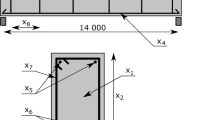Abstract
The objective of multihazard structural engineering is to develop methodologies for achieving designs that are safe and cost-effective under multiple hazards. Optimization is a natural tool for achieving such designs. In general, its aim is to determine a vector of design variables subjected to a given set of constraints, such that an objective function of those variables is minimized. In the particular case of structural design, the design variables may be member sizes; the constraints pertain to structural strength and serviceability (e.g., keeping the load-induced stresses and deflections below specified thresholds); and the objective function is the structure cost or weight. In a multihazard context, the design variables are subjected to the constraints imposed by all the hazards to which the structure is exposed. In this paper, we formulate the multihazard structural design problem in nonlinear programming terms and present a simple illustrative example involving four design variables and two hazards: earthquake and strong winds. Results of our numerical experiments show that interior-point methods are significantly more efficient than classical optimization methods in solving the nonlinear programming problem associated with our illustrative example.
Similar content being viewed by others
References
Potra, F.A., Simiu, E.: Optimization and structural multihazard design. J. Eng. Mech. (2009, accepted for publication)
Wright, M.H.: The interior-point revolution in optimization: history, recent developments, and lasting consequences. Bull. Am. Math. Soc. (N.S.) 42(1), 39–56 (2005) (electronic)
Bertsimas, D., Popescu, I.: On the relation between option and stock prices: a convex optimization approach. Oper. Res. 50(2), 358–374 (2002)
de Klerk, E.: Aspects of Semidefinite Programming. Applied Optimization, vol. 65. Kluwer Academic, Dordrecht (2002)
Freund, R.W., Jarre, F., Vogelbusch, C.H.: Nonlinear semidefinite programming: sensitivity, convergence, and an application in passive reduced-order modeling. Math. Program., Ser. B 109(2–3), 581–611 (2007)
Wolkowicz, H., Saigal, R., Vandenberghe, L. (eds.): Handbook of Semidefinite Programming. International Series in Operations Research & Management Science, vol. 27. Kluwer Academic, Boston (2000)
Author information
Authors and Affiliations
Corresponding author
Additional information
Communicated by A. Miele.
Rights and permissions
About this article
Cite this article
Potra, F.A., Simiu, E. Multihazard Design: Structural Optimization Approach. J Optim Theory Appl 144, 120–136 (2010). https://doi.org/10.1007/s10957-009-9586-4
Published:
Issue Date:
DOI: https://doi.org/10.1007/s10957-009-9586-4




